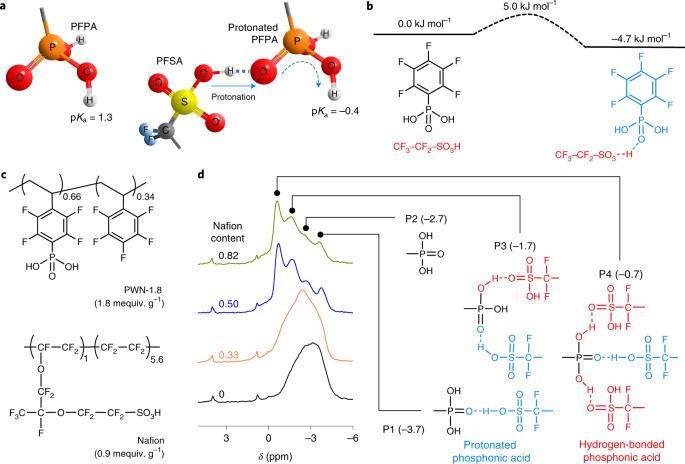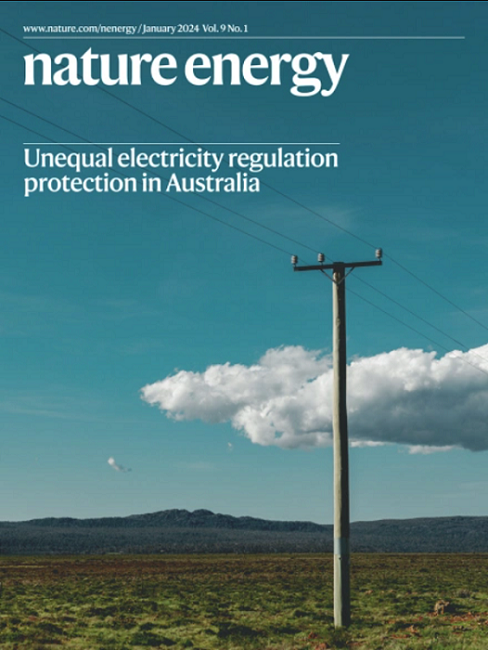Protonated phosphonic acid electrodes for high power heavy-duty vehicle fuel cells
IF 49.7
1区 材料科学
Q1 ENERGY & FUELS
引用次数: 34
Abstract
State-of-the-art automotive fuel cells that operate at about 80 °C require large radiators and air intakes to avoid overheating. High-temperature fuel cells that operate above 100 °C under anhydrous conditions provide an ideal solution for heat rejection in heavy-duty vehicle applications. Here we report protonated phosphonic acid electrodes that remarkably improve the performance of high-temperature polymer electrolyte membrane fuel cells. The protonated phosphonic acids comprise tetrafluorostyrene-phosphonic acid and perfluorosulfonic acid polymers, where a perfluorosulfonic acid proton is transferred to the phosphonic acid to enhance the anhydrous proton conduction of fuel cell electrodes. By using this material in fuel cell electrodes, we obtained a fuel cell exhibiting a rated power density of 780 mW cm–2 at 160 °C, with minimal degradation during 2,500 h of operation and 700 thermal cycles from 40 to 160 °C under load. High-temperature polymer electrolyte membrane fuel cells are promising for heavy-duty vehicle applications, but strides in performance are needed to improve their commercial viability. Here it is demonstrated that protonating phosphonic acid electrodes greatly enhances power density and durability.

用于大功率重型车辆燃料电池的质子膦酸电极
最先进的汽车燃料电池工作温度约为 80 °C,需要大型散热器和进气口来避免过热。在无水条件下工作温度超过 100 °C 的高温燃料电池为重型车辆应用中的热量排出提供了理想的解决方案。我们在此报告的质子化膦酸电极可显著提高高温聚合物电解质膜燃料电池的性能。质子化膦酸由四氟苯乙烯-膦酸和全氟磺酸聚合物组成,其中全氟磺酸质子转移到膦酸中,以增强燃料电池电极的无水质子传导。通过在燃料电池电极中使用这种材料,我们获得了一种额定功率密度为 780 mW cm-2 的燃料电池,温度为 160 °C,在负载条件下从 40 °C到 160 °C,运行了 2,500 小时和 700 次热循环,衰减极小。高温聚合物电解质膜燃料电池在重型汽车上的应用前景广阔,但要提高其商业可行性,还需要在性能上取得长足进步。这里展示的质子化膦酸电极可大大提高功率密度和耐用性。
本文章由计算机程序翻译,如有差异,请以英文原文为准。
求助全文
约1分钟内获得全文
求助全文
来源期刊

Nature Energy
Energy-Energy Engineering and Power Technology
CiteScore
75.10
自引率
1.10%
发文量
193
期刊介绍:
Nature Energy is a monthly, online-only journal committed to showcasing the most impactful research on energy, covering everything from its generation and distribution to the societal implications of energy technologies and policies.
With a focus on exploring all facets of the ongoing energy discourse, Nature Energy delves into topics such as energy generation, storage, distribution, management, and the societal impacts of energy technologies and policies. Emphasizing studies that push the boundaries of knowledge and contribute to the development of next-generation solutions, the journal serves as a platform for the exchange of ideas among stakeholders at the forefront of the energy sector.
Maintaining the hallmark standards of the Nature brand, Nature Energy boasts a dedicated team of professional editors, a rigorous peer-review process, meticulous copy-editing and production, rapid publication times, and editorial independence.
In addition to original research articles, Nature Energy also publishes a range of content types, including Comments, Perspectives, Reviews, News & Views, Features, and Correspondence, covering a diverse array of disciplines relevant to the field of energy.
 求助内容:
求助内容: 应助结果提醒方式:
应助结果提醒方式:


